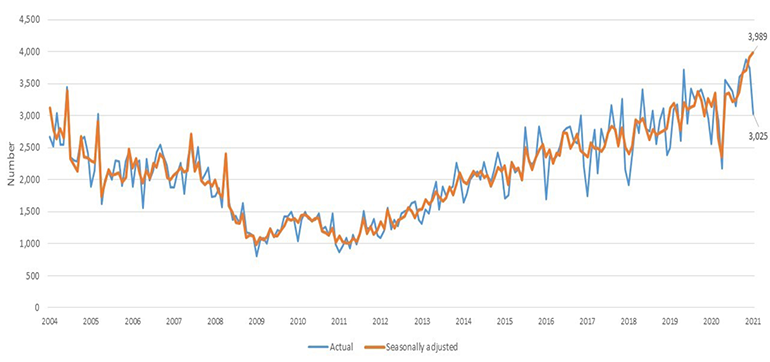Construction sector trends monthly media and information overview: February 2021
An overview of the key research, data, and media releases in February 2021.
On this page
The key themes were:
- Housing demand issues trended through the media, research and data releases in February.
- Research releases address the drivers for housing demand, as well as the use of blockchain by industry.
- Statistics releases show further evidence of tight supply chains, and a slowdown in commercial building.
General summary
Housing demand issues trended through media, research and data releases. Media highlighted the demand for public housing, while one research report focused on the demographic drivers of demand.
Residential building consent volumes continued to rise, according to the latest data releases. Commercial building appeared to be slowing, affected by commercial building activity in Auckland and the longer-term decline in Canterbury (after elevated-levels of building work post-the 2011 earthquake).
Research releases
The NZ Initiative Report, The need to build: The demographic drivers of housing demand, sought to determine the future demand for housing in New Zealand by calculating the long-term population numbers. The report concluded that population growth was not the sole driver of housing demand, but that changes in living arrangements and household composition played a role too i.e., assessing the number of new annual dwellings needed from just population changes severely underestimated the supply needed.
The need to build: The demographic drivers of housing demand(external link) — The New Zealand Initiative
BRANZ published just the one research report in February. Produced by researchers from Auckland University, Chip of the new block(chain): Blockchain and the construction sector is the summary of a two-year research programme which explored what blockchain means for the construction sector. The report recognised that while blockchain technology is still in its infancy, there were some features which presented opportunities for the sector. Specifically, blockchain is a distributed technology that can support small and scalable ‘bottom up’ innovation, and does not necessarily require the large scale investment associated with ‘top down’ innovation, that is associated with significant cost and structural change.
Chip of the new block(chain): Blockchain and the construction sector(external link) — BRANZ
Data releases
The latest statistical releases showed a continuing trend of strong residential consenting volumes, as the demand for housing continues to drive supply. There were 3,025 new homes consented in the January 2021 month, up 18% from January 2020. The annual number of new homes consented in the year ended January 2021 was 39,881, up 5.8% from the year ended January 2020. The high levels of residential consents continued to be driven by increases in consents for multi-unit homes, including apartments, townhouses and flats.
Annual number of new homes consented rises(external link) — Stats NZ
The volume of non-residential building work decreased by 4.9% (seasonally adjusted) in the December 2020 quarter, compared with the September 2020 quarter, particularly in the commercial building space (i.e., shops, offices, storage and accommodation buildings). This reflects changes in commercial building activity within the Auckland region, as well as the long-term decline of building activity within the Canterbury area.
Commerical construction slows, residential holds up(external link) — Stats NZ
The latest Quarterly Building Activity Survey from Stats NZ found that approximately 6 out of 10 respondents from home building projects in Auckland reported an impact on the availability of materials and/or equipment — this reflects the ongoing issues with supply chains worldwide due to COVID-19.
Increased supply pressures reported for home building projects in Auckland(external link) — Stats NZ
Media
There were over 700 building and construction-related media articles generated in February, a marked increase from the over 500 articles produced throughout January 2021.
Trending media content included key themes of: overall housing affordability and supply, increased demand for public housing, COVID-19 impacts on supply chains, construction costs, and commemoration of the 2011 Canterbury earthquake.
The Waikato Times, Nelson Mail and other media outlets, published figures from the Ministry of Housing and Urban Development which detailed a record 22,521 applicants currently on the wait-list for public housing. High-rental costs and a shortage of housing supply were reported as the primary drivers for the high demand for public housing.
Public housing waitlist climbs again(external link) — Stuff
Both the Southland Times and Info News online reported stories outlining COVID-19 impacts on the availability of building supplies. The Southland Times article quoted the Registered Master Builders Association, which believed that suppliers could not keep up with the current demand for products, and that freight from overseas was a significant issue. The Association also stated that there was a noticeable lack of labour, and that there was difficulty finding new, qualified staff to meet the demand from the current, high-levels of building activity around the country.
Supply chain concerns were also noted in a write-up about potential further rising of construction costs, in the Weekend Press and on Stuff.co.nz. The article outlined the drivers for rising costs, such as the high-level of building activity, average wage increases in the construction industry, and the near-record levels of residential building consents. Corelogic (who publish construction cost data online) foresee these drivers as potentially pushing costs up further in the future.
Cost pressures in busy construction industry start to ramp up(external link) — Stuff
Most media publications had various articles commemorating the 10 year anniversary of the 2011 Canterbury earthquake. These stories varied from remembrance pieces featuring interviews with residents who were impacted by the earthquake, to articles looking at the on-going ramifications of it. Stuff.co.nz had an investigative piece which looked at why so many Christchurch buildings were still derelict and unoccupied, a decade after the event.
The Christchurch buildings still empty 10 years after the February quake(external link) — Stuff
Number of monthly residential building consents (January 2004 to January 2021)

Image description

